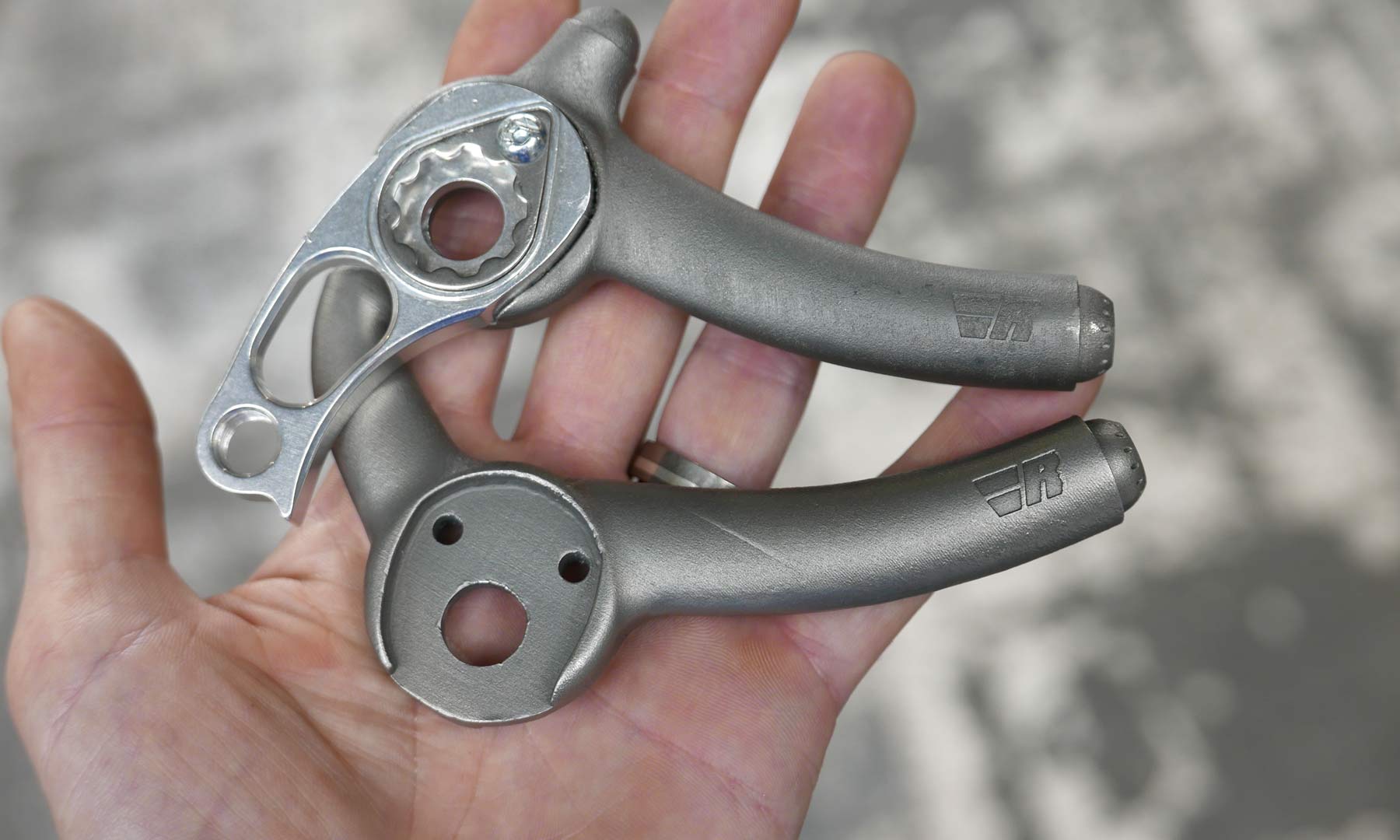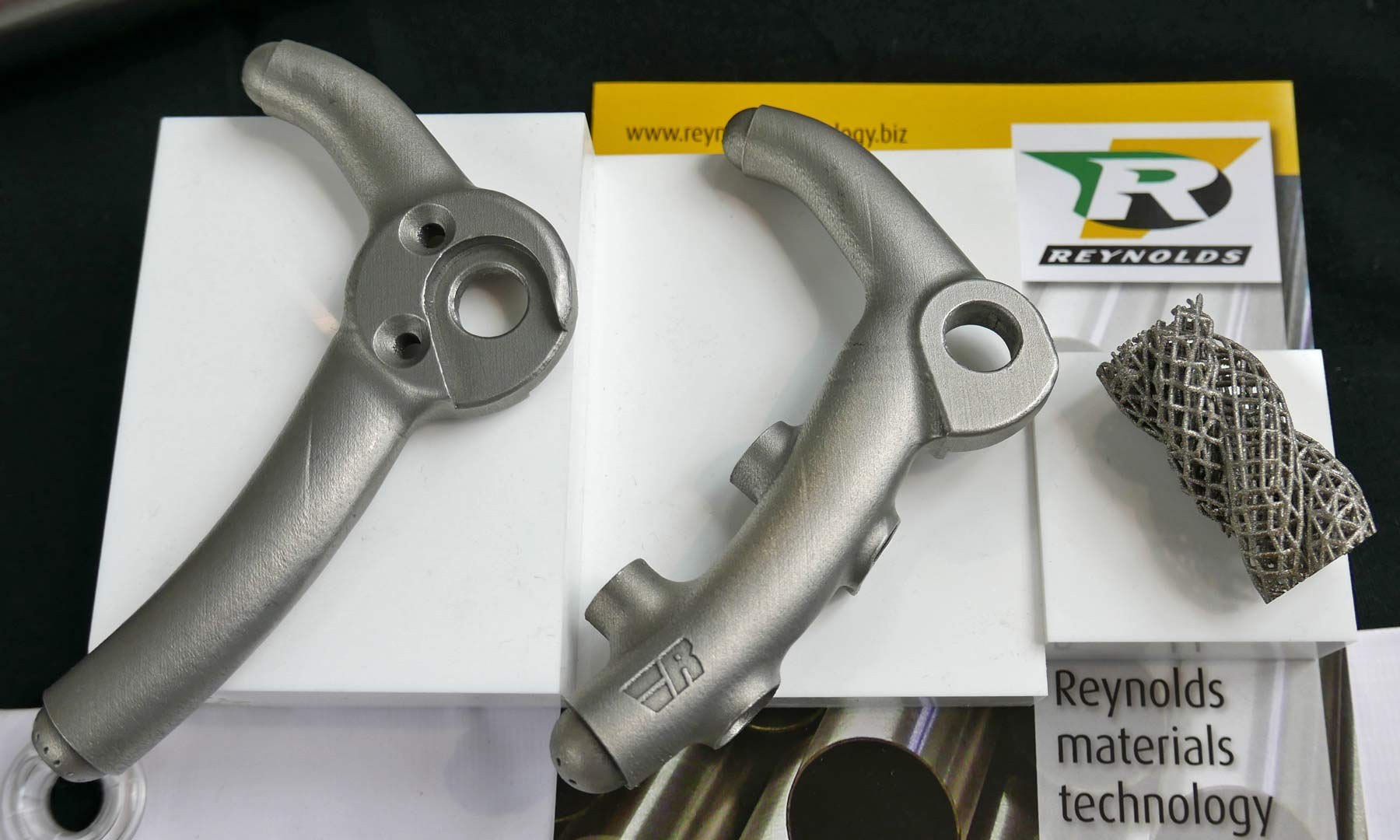Of the two Reynolds 3D printed driveside dropouts in my hand above, one is made of titanium, and the other of stainless steel. Can you tell them apart?
We’ve been seeing 3D printed titanium parts for a few years. Back at NAHBS in 2016 we saw the first iteration of these specific 3D printed ti dropouts as a production item from Reynolds where they were welded into a Ti Cycles frame. Reynolds have also worked closely with Independent Fabrications furthering the concept beyond dropouts. The idea is to make it easier to fabricate, and actually cheaper to incorporate more complex features like thru-axles and flat mount discs in a welded ti frame. Well just as titanium is difficult to work with, so is stainless steel. So Reynolds has been working to replicate the same 3D printing/additive manufacturing techniques to stainless as well, and it has been more difficult than one would expect.
(Btw, the stainless dropout is the one at the bottom of the image above, with the upper dropout from titanium and fitted with its machined aluminum hanger. The material are almost indistinguishable. All other images below are 3D printed stainless steel. Did you guess correctly?)
Reynolds 3D printed stainless steel technology
Where 3D printing really shines is making complex small parts and integrating key features without the need for excess material. Creating a hollow component means it can be lightweight, while retaining all of the rigidity.
Stainless steel is a perfect example of this as the higher modulus of the material can allow Reynolds to make much thinner elements than they would do with titanium, while retaining stiffness. Of course, thinner parts require more precision in manufacturing. And Reynolds says they’ve discovered that the 3D printing technology has required much more focus for stainless steel than titanium. But they are making big progress in producing ever-lighter parts as they progress through R&D.
 Beyond the dropout, Reynolds is really looking at feature integration as frame builders join tubing together. Even though metal tubes are more forgiving to having holes drilled into them and even being shaped & crimped, Reynolds would prefer that frame builders didn’t have to modify the more advanced tubing that they produce. By 3D printing elements like headtubes and bottom bracket clusters, they can carefully integrate features like internal routing into a frame, while reinforcing all openings. The result can be significantly lighter parts, overall lighter frames, improved mechanical performance, and easier frame construction for the builder at the same time.
Beyond the dropout, Reynolds is really looking at feature integration as frame builders join tubing together. Even though metal tubes are more forgiving to having holes drilled into them and even being shaped & crimped, Reynolds would prefer that frame builders didn’t have to modify the more advanced tubing that they produce. By 3D printing elements like headtubes and bottom bracket clusters, they can carefully integrate features like internal routing into a frame, while reinforcing all openings. The result can be significantly lighter parts, overall lighter frames, improved mechanical performance, and easier frame construction for the builder at the same time.
Reynolds developed this stainless BB with Indy Fab and their 3D printing partner to optimize the high stress area. It also allowed them to build in better clearance for wide gravel tires and the chainrings, plus internal guides for continuous internal cable routing. Reynolds says that combined with a 3D printed headtube and dropouts they propose fully internal shift routing (and external brake routing outside of the chainstay) that eliminates the need to drill any holes into the lightweight tubing for a really clean look.
Reynolds is for the most part a tubing maker, so they have been working with their local 3D printing specialists Renishaw PLC to develop the additive manufactured stainless steel parts. A key part of that is the parametric design software, which allows them to customize each set of droputs or bottom bracket with a few clicks to perfectly align the angles or even the BB standard diameter a frame needs. The base design stays, but is quickly and easily customizable for each bike without additional (prohibitive) design & development costs.
The benefits are big for stainless as well, because it also offers more flexibility for framebuilders. The components being developed can be incorporated into a wider range of steel bikes being built and can be either welded or brazed. The dropouts themselves tend to be much more expensive than a plate-style cut, forged, or even 3D machined part, but for one-off geometry they can save the builder a lot of actual manufacturing time.
 Of course it is not just frame building components. No reputable cycling industry company could develop a technology and not figure out how to open a beer with it, right? Reynolds showed us that 3D printed stainless steel can successfully open a post-ride brew. Unfortunately, these would cost so much to make, they are very unlikely to become a standard product (they wouldn’t even give me one!)
Of course it is not just frame building components. No reputable cycling industry company could develop a technology and not figure out how to open a beer with it, right? Reynolds showed us that 3D printed stainless steel can successfully open a post-ride brew. Unfortunately, these would cost so much to make, they are very unlikely to become a standard product (they wouldn’t even give me one!)
The frame building components however are more viable. Ti dropouts are available to frame builders now, and ti bottom brackets to a more limited degree. The stainless steel 3D printed parts are expected to be available by the end of April 2018.


